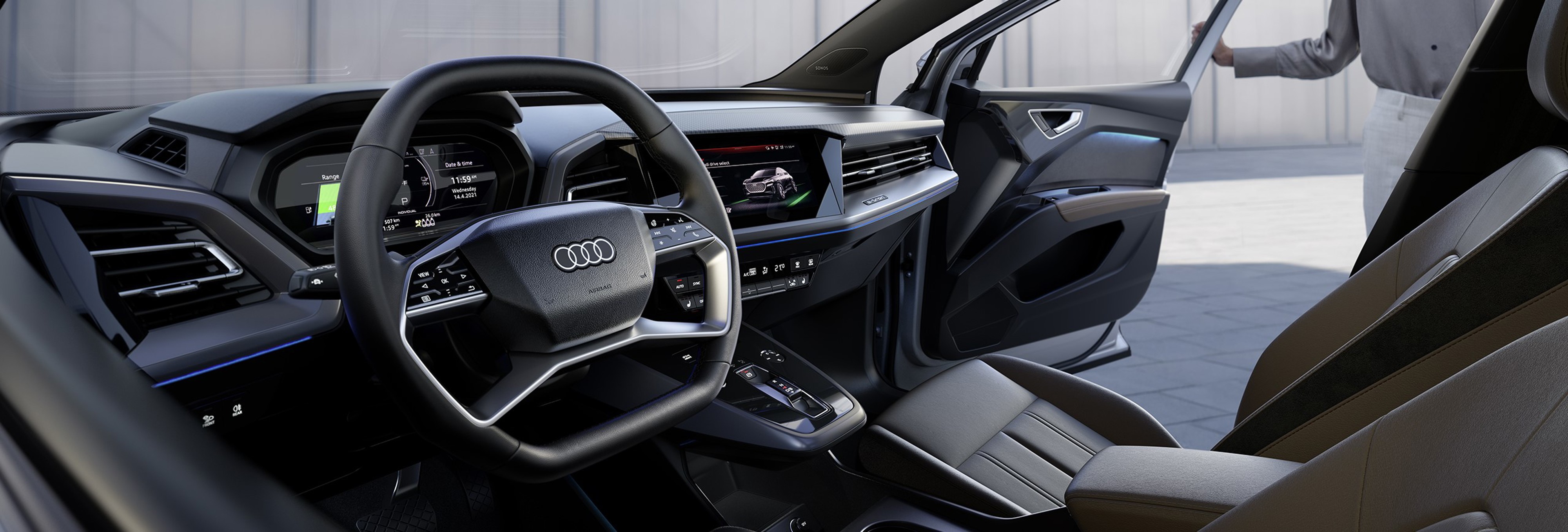Advertisement feature from Audi

With an impressive electric range of up to 321 miles (official test figure)*, the Audi Q4 e-tron can fulfil any driving requirement, helping to reduce driver anxiety and the need to constantly recharge.
As a result of these desirable benefits, the Audi Q4 e-tron’s rise to the top has been swift: within just two years of launch, it has become one of the best-selling electric cars in the UK, with more than 7,000 registrations. It is also Audi’s most popular electric vehicle, accounting for 70% of its electric sales.

Combining competitive total cost of ownership for fleet operators with exceptionally low benefit-in-kind tax for drivers, this progressive compact SUV is packed with the latest technology, including extensive driver assistance equipment (lane departure warning, pre-sense front, traffic sign recognition) and advanced infotainment.
It also tugs at the heartstrings with its stylish design, high quality interior and exceptional driving experience, but doesn’t forgo crucial practicalities, such as offering generous space for passengers and their luggage.

The ride is as comfortable and refined as you’d expect from a premium SUV.
Further plus points underlining its appeal to fleets include rapid charging: the Audi Q4 e-tron can be rapid-charged from 5-80% in just 29 minutes* on a 150kW unit.
Discover more about the Audi electric fleet here
Prices from £51,325**
Benefit-in-kind (BIK) tax from £17 a month
Range 293-321 miles (depending on trim)
0-62mph 8.5 seconds
Maximum DC charging capacity 150kW
Battery from 5-80% in 29 minutes
Battery capacity 76.6kWh
Click here for the latest prices
Find out more about the Audi Q4 e-tron here


A BiK of £16.86 per month is payable by customers who purchase a Q4 e-tron 45 Sport SUV (P11d value £50,575) and are basic rate tax payers (20%). The BiK payable is dependent on your car (including choice of trim, wheels and other options), P11d value, its emissions and your tax band. The price and charges you pay may differ from any prices or charges displayed or quoted.
Range: dependent on trim and optional equipment. All vehicles are tested according to WLTP technical procedures. Figures shown are official test values for comparability purposes; only compare fuel consumption, CO2 and electric range figures with other vehicles tested to the same technical procedures. These figures may not reflect real life driving results, which will depend upon a number of factors including but not limited to factory fitted options, accessories fitted (post-registration), variations in weather, road and traffic conditions, individual driving styles, vehicle load, vehicle condition, use of systems like climate control (and, for battery electric vehicles, the starting charge, age and conditions of the battery). Figures for battery electric vehicles were obtained after the battery had been fully charged. Battery electric vehicles require mains electricity for charging. Zero emissions while driving. Figures quoted are subject to change due to ongoing approvals/changes and figures may include options not available in the UK. Please consult your local Audi Centre for further information. Data correct in July 2023. Lithium-ion batteries, of the type used in most electric vehicles (including Audi electric vehicles) have a restricted lifespan. Battery capacity will reduce over time, with use and charging. Reduction in battery capacity will affect the performance of the vehicle, including the range achievable, and may impact resale value. New car performance figures (including battery capacity and range) may be provided for the purposes of comparison between vehicles. You should not rely on new car performance figures (including battery capacity and range), in relation to used vehicles with older batteries, as they will not reflect used vehicle performance in the real world. For further information on batteries and the Audi 8 year/100,000 mile battery warranty, please visit https://www.audi.co.uk/uk/web/en/electric/faqs/battery.html.

















Login to comment
Comments
No comments have been made yet.